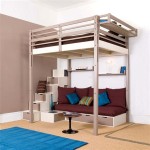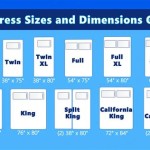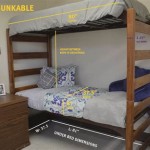What Size Rug Goes Under a Full Size Bed?
Selecting the correct rug size for placement under a full-size bed can significantly impact a bedroom's aesthetic appeal and overall functionality. A rug that is too small can appear disproportionate and diminish the room's sense of spaciousness, while a rug that is too large may overwhelm the space and clash with existing furniture. Therefore, understanding the standard dimensions of a full-size bed and the various rug placement options is crucial for achieving a visually balanced and comfortable bedroom environment.
A full-size bed, also known as a double bed, typically measures approximately 54 inches wide by 75 inches long. Converting these measurements into feet, a full-size bed is roughly 4.5 feet wide and 6.25 feet long. These dimensions serve as the baseline for determining the appropriate rug size. However, considering the room's overall size, the placement of other furniture, and the desired aesthetic are equally important when making a final decision. There is no single perfect rug size; rather, the ideal size depends on individual preferences and the specific characteristics of the bedroom.
The objective is to create a harmonious relationship between the bed, the rug, and the surrounding space. A well-chosen rug can anchor the bed, define the sleeping area, and add texture and warmth to the room. Conversely, an incorrectly sized or poorly placed rug can disrupt the visual flow and create an unsettling or cluttered feel. Therefore, careful consideration should be given to several factors before making a purchase.
Considering Rug Placement Options
The placement of the rug under a full-size bed is a key determinant of the optimal rug size. Several common placement strategies exist, each with its own advantages and disadvantages. These strategies primarily revolve around how much of the rug extends beyond the perimeter of the bed, particularly at the foot and sides. Understanding these options allows for a more informed decision based on the specific room layout and desired aesthetic.
One common option is to place the rug so that it extends beyond the sides and foot of the bed, leaving the headboard directly on the floor. This provides a soft surface to step onto when getting out of bed and creates a more visually balanced look. Another strategy involves placing the rug entirely under the bed, extending a significant distance on all sides. This is often employed in larger bedrooms to create a more luxurious and cohesive feel. Finally, a smaller rug can be placed only at the foot of the bed, serving primarily as a decorative accent and providing a soft landing for feet upon waking.
The choice of placement significantly influences the rug size needed. For instance, if the rug is intended to extend significantly beyond all sides of the bed, a larger rug will be required compared to the scenario where it is only placed at the foot. Therefore, visualizing the placement before measuring and purchasing a rug is crucial.
When deciding on a placement strategy, it is also important to consider the amount of exposed flooring. Some individuals prefer to have a substantial amount of hardwood or tile visible, while others prefer a more carpeted feel. The chosen rug placement should reflect this preference and contribute to the overall desired ambiance of the bedroom.
Recommended Rug Sizes for Each Placement Style
Based on the common rug placement options, specific rug sizes are generally recommended for a full-size bed. These recommendations provide a useful starting point, but should be adjusted based on the specific dimensions of the room and personal preferences.
For a rug that extends beyond the sides and foot of the bed, a rug measuring 8 feet by 10 feet is often a good choice. This size allows for approximately 2 to 3 feet of rug to extend beyond the sides of the bed, providing a comfortable and visually appealing landing space. It also provides ample coverage at the foot of the bed, ensuring a balanced look.
If the rug is intended to be placed entirely under the bed, extending significantly on all sides, a larger rug, such as a 9 feet by 12 feet rug, may be more appropriate. This size ensures that the rug extends a sufficient distance beyond the headboard, sides, and foot of the bed, creating a sense of spaciousness and luxury. This option is most suitable for larger bedrooms where the rug will not overwhelm the space.
For a rug placed only at the foot of the bed, a smaller rug, such as a 5 feet by 8 feet rug or even a runner rug, can be effective. This approach is often used for decorative purposes or to provide a soft landing spot. In this case, the rug should extend at least a few feet beyond the foot of the bed to be functionally useful and visually appealing.
It's crucial to remember that these are merely suggestions. The best way to determine the ideal rug size is to measure the area where the rug will be placed and visualize how different rug sizes will look in the space. Using painter's tape to mock up the dimensions of different rug sizes can be a helpful way to visualize the final outcome before making a purchase.
Considering Room Size and Other Furniture
Beyond the bed itself, the overall size of the bedroom and the placement of other furniture play significant roles in determining the appropriate rug size. A small bedroom may feel cramped and overwhelmed by a large rug, while a large bedroom may require a larger rug to fill the space effectively.
Consider the placement of other furniture, such as nightstands, dressers, and chairs. Ideally, the rug should either extend beneath these pieces or be positioned to avoid partially covering them. Partially covering furniture can create an unbalanced and awkward look. For example, if the nightstands are placed beside the bed, ensure that the rug extends far enough to either fully encompass them or be positioned in a way that leaves them entirely on the bare floor.
The distance between the bed and other furniture is also an important consideration. In a small bedroom, maximizing the amount of open floor space is crucial. In this case, a smaller rug that extends primarily around the bed may be a more practical choice. In a larger bedroom, a larger rug can help to define the sleeping area and create a more cohesive and inviting feel.
The rug should also complement the existing decor and color scheme of the room. Choose a rug that aligns with the style and color palette of the bedroom to create a harmonious and visually appealing space. Texture is also an important factor, with different textures adding different levels of warmth and interest to the room. A plush rug can create a cozy and inviting atmosphere, while a flat-weave rug can offer a more modern and streamlined look.
Ultimately, selecting the right rug size and placement for a full-size bed involves careful consideration of the bed's dimensions, the rug placement options, the room's size, and the existing furniture. By taking all of these factors into account, it is possible to choose a rug that enhances the bedroom's aesthetic appeal, adds comfort and warmth, and creates a visually balanced and inviting space.

How To Choose The Best Rug For Under Your Bed 136 Home

What Size Rug Should I Use Under A Bed Mcqueens Interiors

Everything To Know About Placing A Rug Under Your Bed

How To Choose The Best Rug For Under Your Bed 136 Home

What Size Rug Do You Need For A Queen Bed Tsar Carpets

Rug Size Guide For A Bedroom Furniture Layout Placement

What Size Rug For California King Bed Bedroom Placement Area

Bedroom Rug Over Carpet Honey We Re Home

What Size Area Rug For Queen Bed Dingmun

How To Choose The Best Rug For Under Your Bed 136 Home








